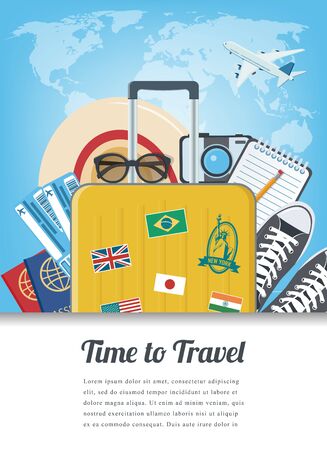Understanding Travel Insurance: Why It Matters for Long-Term Travelers
If you’re planning to travel internationally for months at a time or are living the digital nomad lifestyle, travel insurance probably isn’t just another checkbox—it’s a real necessity. Many of us start out thinking travel insurance is only for emergencies, but there’s much more to it, especially if you’ll be away from home for an extended period. Travel insurance typically covers things like medical emergencies, unexpected trip cancellations, lost luggage, and even emergency evacuation. For long-term travelers and digital nomads, these protections become even more important because being abroad for a longer time simply increases your chances of needing help with something unplanned.
One big misconception is that your regular health insurance will cover you everywhere you go, but most US health plans won’t cover you once you leave the States. Another myth is that travel insurance is only about medical issues. In reality, it often helps with stolen electronics (which matters a lot if your laptop is your office), missed flights due to unforeseen circumstances, or even legal assistance in foreign countries.
It’s also easy to underestimate how expensive healthcare or emergency services can be in another country. A simple doctor’s visit or a night in the hospital can cost hundreds or thousands of dollars without coverage—and paying that out-of-pocket could seriously mess up your budget or savings.
Understanding what travel insurance really covers—and what it doesn’t—is key before you start your journey. That way, you’ll avoid surprises and make smarter choices as a long-term traveler or digital nomad.
2. Key Features to Look for in a Policy
When choosing travel insurance as a long-term international traveler or digital nomad, it’s important to find a policy that fits your unique lifestyle. Since you might be on the road for months or even years, you need coverage that goes beyond what regular vacationers need. Here are the essential features you should look for:
Medical Coverage
This is probably the most critical part of any travel insurance policy. Make sure your plan covers both emergency and non-emergency care, including doctor visits, hospital stays, prescriptions, and urgent dental treatment. For digital nomads who may work from different countries each month, worldwide coverage without strict country exclusions is key.
Trip Interruption and Cancellation
Plans change—flights get canceled, family emergencies happen, or political unrest may force you to leave a country sooner than expected. A good policy will reimburse non-refundable expenses if your plans are disrupted for covered reasons. This helps protect your investment, especially if you book flights or accommodation far in advance.
Personal Belongings Protection
As someone traveling with expensive tech gear like laptops and cameras, personal belongings coverage is essential. Check policy limits and make sure electronics are included (some plans require extra riders for high-value items). This coverage can help replace your essentials if they’re stolen, lost, or damaged.
Evacuation and Repatriation
If you face a medical emergency in a remote area, evacuation coverage can save you thousands of dollars by paying for airlifts or transport to an appropriate facility. Repatriation covers getting you home in case of severe illness or after death—something no one wants to think about, but it’s wise to be prepared.
Quick Comparison Table: Essential Policy Components
| Feature | Why It Matters | What to Check |
|---|---|---|
| Medical Coverage | Pays for healthcare abroad | Worldwide coverage, high limits, pre-existing conditions? |
| Trip Interruption/Cancellation | Protects prepaid expenses | Covered reasons, reimbursement process |
| Personal Belongings | Covers theft/loss/damage of valuables | Electronics limit, claims procedure |
| Evacuation & Repatriation | Covers costly emergency transport | Coverage amount, 24/7 support hotline |
Take time to read the fine print and compare policies carefully. The right insurance gives you confidence as you explore new places and take on adventures as a digital nomad!

3. Navigating Pre-Existing Conditions and Coverage Limits
One of the trickiest parts about buying travel insurance—especially if you’re planning to be abroad for months at a time—is figuring out how pre-existing medical conditions are covered, and understanding the maximum limits on what your policy will actually pay out. In the U.S., travel insurance companies define pre-existing conditions as any illness, injury, or medical issue you had before your coverage start date—even if it was diagnosed years ago. If you’ve ever seen a doctor for something, it’s usually considered “pre-existing.”
Some insurers simply don’t cover pre-existing conditions at all, while others might offer a waiver if you buy your policy within a certain window after making your first trip payment (often 14-21 days). This is why it’s super important to read the fine print or call and ask questions before purchasing. If you take regular medication or have ongoing health issues like asthma, diabetes, or even high blood pressure, make sure you know exactly what’s included—and what isn’t—so you aren’t caught off guard in another country.
Another thing many first-timers overlook is the concept of coverage caps. Every travel insurance plan has a maximum payout limit for different kinds of claims: emergency medical care, evacuation, baggage loss, and more. For long-term travelers and digital nomads, these limits really matter because a major accident or illness could easily exceed basic coverage amounts. Look for policies with higher medical expense limits (ideally $100,000 USD or more) and double-check if there are sub-limits for specific treatments or situations (like dental emergencies or adventure sports injuries). Remember: the cheapest plan might not give you enough protection when you actually need it most.
4. Choosing Insurance: US-Based vs. International Providers
As a long-term international traveler or digital nomad, deciding between US-based and international travel insurance providers can feel overwhelming—especially if you’re new to the world of global living. Both options have their pros and cons, and finding a reliable insurer is crucial for peace of mind while you’re abroad. Here’s a breakdown to help you make an informed choice:
Comparison: US-Based vs. International Travel Insurance Brands
| Feature | US-Based Providers | International Providers |
|---|---|---|
| Coverage Area | Mainly for Americans, sometimes limited outside US | Worldwide, often more flexible for multi-country travel |
| Customer Support | Stronger US support, easier to reach in English & by phone | Global support, but may vary by time zone/language |
| Payment & Claims | Easier payment with US banks; claims may require mailing paperwork | More online claim options; sometimes faster payouts for expats |
| Regulation/Trust | Regulated by US laws (more familiar for Americans) | Regulated internationally; some brands widely trusted among nomads |
| Price & Flexibility | Can be pricier; good for trips starting/ending in US | Often cheaper, better for continuous travel without return dates |
Tips for Finding Reliable U.S. Insurer Options Abroad
- Check State Licensing: Make sure any US-based insurer is licensed in your home state—this helps with legal protection if you need to file a complaint.
- Look for Global Networks: Some American brands partner with international networks (like Allianz or GeoBlue), which means better hospital access overseas.
- User Reviews Matter: Read real-life reviews on platforms like Trustpilot or Reddit’s r/digitalnomad for the latest info on how companies handle claims abroad.
- Understand Exclusions: Many US-based plans don’t cover you if you stay outside the States too long. Check the fine print about residency or trip length limits.
- Ask About Direct Billing: If you’ll be abroad long-term, find out if the insurer pays hospitals directly—so you’re not stuck paying huge bills upfront.
- Compare Nomad-Friendly Plans: Look into plans specifically marketed to expats and nomads (like SafetyWing or IMG Global). These often combine the best of both worlds.
If you’re just starting out as a digital nomad or planning your first year abroad, it’s smart to get quotes from both American and international insurers. Make a list of your must-haves (like emergency evacuation or mental health coverage), compare policy wording carefully, and don’t hesitate to contact customer service with your questions before buying. It’s all part of learning how to protect yourself while exploring the world!
5. Making a Claim: What US Nomads Wish They Knew
If you’re a long-term traveler or digital nomad from the US, making a travel insurance claim can feel overwhelming, especially when you’re far from home. But with a little preparation and some know-how, the process doesn’t have to be stressful. Here’s a straightforward, step-by-step guide that many American nomads wish they’d known before their first claim.
Step 1: Save Every Receipt and Document
This might sound obvious, but it’s easy to forget when you’re on the go. After any incident—whether it’s a doctor visit or replacing stolen gear—immediately ask for detailed receipts and official documentation. For medical claims, request an itemized bill and a medical report in English if possible. For theft or loss, file a police report right away and keep a copy. Digital backups (like photos or scans) are just as important as paper originals.
Step 2: Know Your Policy Exclusions
Before you even need to make a claim, take time to read through your policy’s exclusions. Many US travelers are surprised to learn that adventure sports injuries, pre-existing conditions, or lost cash aren’t covered. If you’re unsure about any terms, contact your provider for clarification—most offer live chat or toll-free numbers. Understanding these details will help avoid disappointment and wasted effort later on.
Step 3: Start Your Claim ASAP
Time is of the essence! Most insurers require claims to be filed within a certain window (sometimes as short as 30 days after the incident). Log into your insurance portal or use their mobile app to start your claim promptly. Upload all supporting documents and double-check your information before submitting.
Pro Tip: Communicate Clearly
If your insurance provider is based outside the US, don’t assume they understand American healthcare or billing practices. Write clear explanations and consider including context about the situation. If you’re ever in doubt, ask for help—many companies have dedicated claim support teams familiar with US travelers’ needs.
Getting Support From Providers
If you hit roadblocks or face delays, don’t give up! Reach out via email, phone, or even social media if necessary. Stay polite but persistent; sometimes claims get stuck simply because of miscommunication or missing paperwork. Some providers even offer live claim tracking so you can stay updated on your case’s progress.
By preparing ahead of time and following these steps, you’ll make it much easier to get reimbursed for unexpected expenses while living your digital nomad dream abroad.
6. Budgeting for Insurance: Getting the Best Value
Finding the right balance between affordability and solid coverage is a big concern for long-term international travelers and digital nomads. Here are some practical tips to help you get the most value from your travel insurance without breaking the bank.
Know Your Coverage Priorities
First, make a list of must-have protections, like emergency medical coverage, evacuation, trip interruption, or coverage for tech gear. Don’t pay extra for things you don’t need, but don’t skimp on essentials either. This helps you avoid unnecessary costs while staying protected.
Use U.S. Credit Card Benefits Wisely
If you have a U.S.-issued credit card, check what built-in travel protections it offers. Many premium cards include trip cancellation, rental car insurance, and even some medical coverage when you pay for your trip with the card. These perks can sometimes cover short trips or specific incidents, letting you buy less additional insurance. Just be sure to read the fine print—coverage limits and exclusions can vary widely.
Consider Annual Multi-Trip Plans
If you’re hopping between countries throughout the year, look into annual multi-trip travel insurance plans instead of buying separate policies for each journey. These plans usually cover unlimited trips within a 12-month period (each with a maximum trip length). While upfront costs seem higher, they often save money in the long run and simplify paperwork.
Compare Quotes and Read Reviews
Don’t just go with the first option you find. Use comparison sites to check prices and benefits side by side. Also, read user reviews to learn about real experiences with claims and customer service—sometimes paying a little more is worth it if it means smoother support abroad.
Tip: Mix and Match for Flexibility
Some travelers use a mix of insurance: relying on credit card benefits for certain parts of their trip and buying supplemental coverage for gaps (like medical evacuation). This approach can help keep costs low while ensuring you’re not exposed to major risks.
Ultimately, budgeting for travel insurance isn’t about finding the absolute cheapest plan—it’s about matching your needs with smart spending so you can travel longer and worry less.

